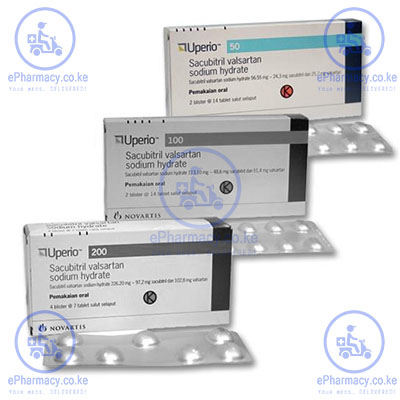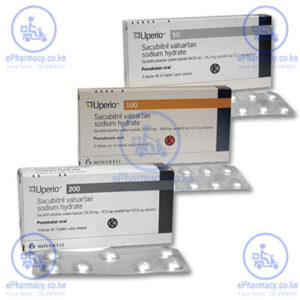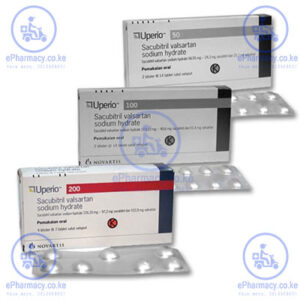Description
Pharmacotherapeutic group: Agents acting on the renin-angiotensin system; angiotensin II antagonists, other combinations. ATC code: C09DX04.
Pharmacology: Mechanism of action (MOA): UPERIO exhibits the novel mechanism of action of an angiotensin receptor neprilysin inhibitor (ARNI) by simultaneously inhibiting neprilysin (neutral endopeptidase; NEP) via sacubitrilat, the active metabolite of the prodrug sacubitril, and by blocking the angiotensin II type-1 (AT1) receptor via valsartan. The complementary cardiovascular benefits and renal effects of UPERIO in heart failure patients are attributed to the enhancement of peptides that are degraded by neprilysin, such as natriuretic peptides (NP), by sacubitrilat and the simultaneous inhibition of the deleterious effects of angiotensin II by valsartan. NPs exert their effects by activating membrane-bound guanylyl cyclase-coupled receptors, resulting in increased concentrations of the second messenger cyclic guanosine monophosphate (cGMP), thereby promoting vasodilation, natriuresis and diuresis, increased glomerular filtration rate and renal blood flow, inhibition of renin and aldosterone release, reduction of sympathetic activity, and anti-hypertrophic and anti-fibrotic effects. Sustained activation of the renin-angiotensin-aldosterone system results in vasoconstriction, renal sodium and fluid retention, activation of cellular growth and proliferation, and subsequent maladaptive cardiovascular remodeling. Valsartan inhibits detrimental cardiovascular and renal effects of angiotensin II by selectively blocking the AT1 receptor, and also inhibits angiotensin II-dependent aldosterone release.
Pharmacodynamics (PD): The pharmacodynamic effects of UPERIO were evaluated after single and multiple dose administrations in healthy subjects and in patients with heart failure, and are consistent with simultaneous neprilysin inhibition and RAAS blockade. In a 7-day valsartan-controlled study in patients with reduced ejection fraction (HFrEF), administration of UPERIO resulted in an initial increase in natriuresis, increased urine cGMP, and decreased plasma MR-proANP and NT-proBNP compared to valsartan. In a 21-day study in HFrEF patients, UPERIO significantly increased urine ANP and cGMP and plasma cGMP, and decreased plasma NT-proBNP, aldosterone and endothelin-1 compared to baseline. UPERIO also blocked the AT1-receptor as evidenced by increased plasma renin activity and plasma renin concentrations. In PARADIGM-HF, UPERIO decreased plasma NT-proBNP and increased plasma BNP and urine cGMP compared with enalapril. While BNP is a neprilysin substrate, NT-proBNP is not. Therefore, NT-proBNP (but not BNP) is a suitable biomarker for monitoring of heart failure patients treated with UPERIO.
In a thorough QTc clinical study in healthy male subjects, single doses of 400 mg and 1200 mg UPERIO had no effect on cardiac repolarization.
Neprilysin is one of multiple enzymes involved in the clearance of amyloid-beta (A-beta) from the brain and cerebrospinal fluid (CSF). Administration of UPERIO 400 mg once daily for 2 weeks to healthy subjects was associated with an increase in CSF A-beta 1-38 compared to placebo; there were no changes in concentrations of CSF A-beta 1-40 and 1-42. The clinical relevance of this finding is unknown (see Nonclinical studies as follows).
Clinical studies: Dosing in clinical trials was based on the total amount of both components of Uperio, i.e., 24/26 mg, 49/51 mg and 97/103 mg were referred to as 50 mg, 100 mg, and 200 mg, respectively.
PARADIGM-HF: PARADIGM-HF was a multinational, randomized, double-blind study of 8,442 patients comparing UPERIO to enalapril, both given to adult patients with chronic heart failure, NYHA class II-IV, and systolic dysfunction (left ventricular ejection fraction ≤ 40%), in addition to other heart failure therapy. The primary endpoint was the composite of cardiovascular (CV) death or hospitalization for heart failure (HF).
Prior to study participation, patients were well treated with standard of care therapy which included ACE inhibitors/ARBs (>99%), beta-blockers (94%), mineralocorticoid antagonists (58%), and diuretics (83%). The median follow- up duration was 27 months and patients were treated for up to 4.3 years.
Patients were required to discontinue their existing ACE inhibitor or ARB therapy and entered a sequential single-blind run-in period during which patients received treatment with enalapril 10 mg twice daily, followed by treatment with UPERIO 100 mg twice daily, increasing to 200 mg twice daily. Patients were then randomized to the double-blind period of the study to receive either UPERIO 200 mg or enalapril 10 mg twice daily [UPERIO (n= 4209); enalapril (n= 4233)].
The mean age of the population studied was 64 years of age and 19% were 75 years or older. At randomization, 70% of patients were NYHA Class II and 25% were Class III/IV.
In the UPERIO group, 76% of patients remained on the target dose of 200 mg twice daily at the end of the study (mean daily dose of 375 mg). In the enalapril group, 75% of patients remained on the target dose of 10 mg twice daily at the end of the study (mean daily dose of 18.9 mg).
UPERIO demonstrated clinically relevant and statistically significant superiority to enalapril, reducing the risk of cardiovascular death or heart failure hospitalizations by 20% (hazard ratio (HR): 0.80, 95% CI [0.73; 0.87], 1-sided p =0.0000002) versus enalapril. This effect was observed early and was sustained throughout the duration of the trial. The absolute risk reduction was 4.69%. A statistically significant reduction for CV death and first HF hospitalization was observed (CV death, RRR 20%, HR 0.80; 95% CI [0.71, 0.89], 1-sided p= 0.00004; and hospitalization for heart failure RRR 21%; HR 0.79; 95% CI 0.71, 0.89], 1-sided p= 0.00004); see Table1 and Figure 1. Sudden death accounted for 45% of cardiovascular deaths and was reduced by 20% in UPERIO treated patients compared to enalapril treated patients (HR 0.80, p= 0.0082).
Pump failure accounted for 26% of cardiovascular deaths and was reduced by 21% in UPERIO treated patients compared to enalapril treated patients (HR 0.79, p = 0.0338).
This risk reduction was consistently observed across subgroups including: age, gender, race, geography, NYHA class, ejection fraction, renal function, history of diabetes or hypertension, prior heart failure therapy, and atrial fibrillation.
UPERIO also significantly reduced all-cause mortality by 16% compared with enalapril (RRR 16%, HR 0.84; 95% CI [0.76 to 0.93], 1-sided p=0.0005) (Table 1). The absolute risk reduction was 2.84%. (See Table 1.)




Reviews
There are no reviews yet.